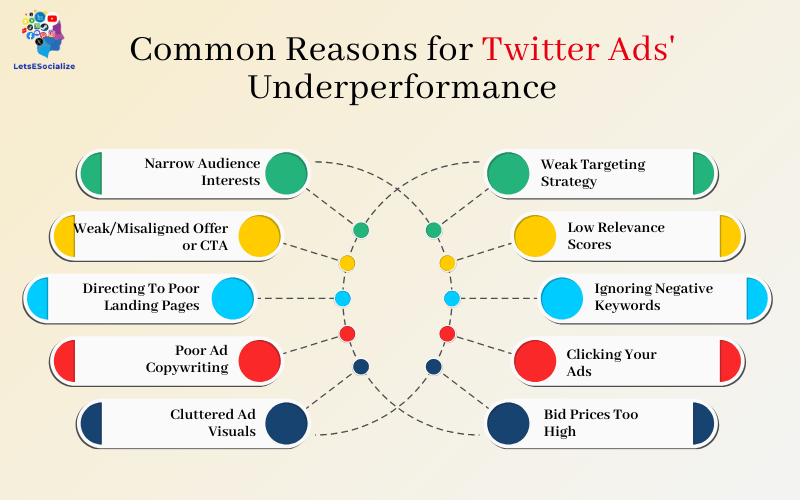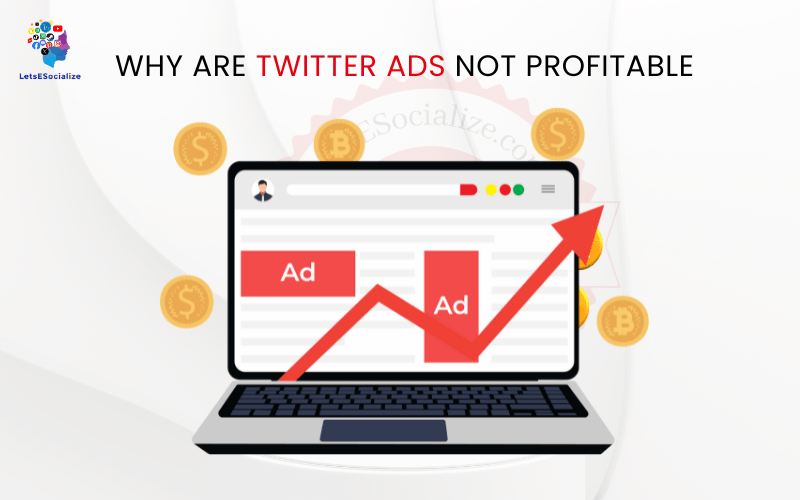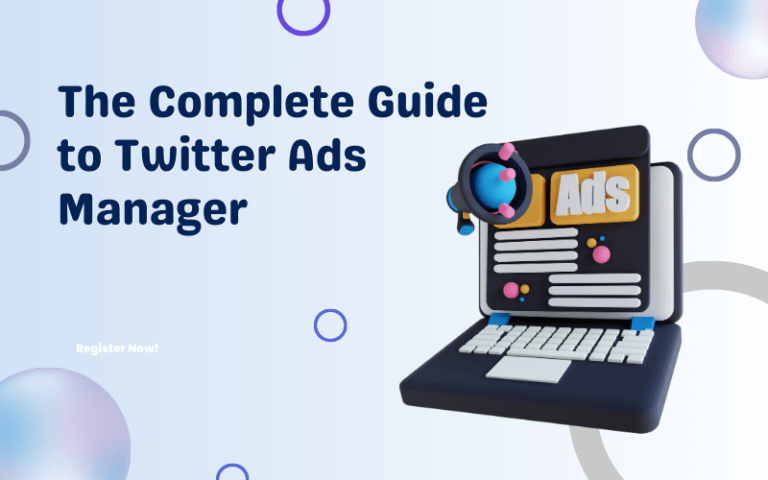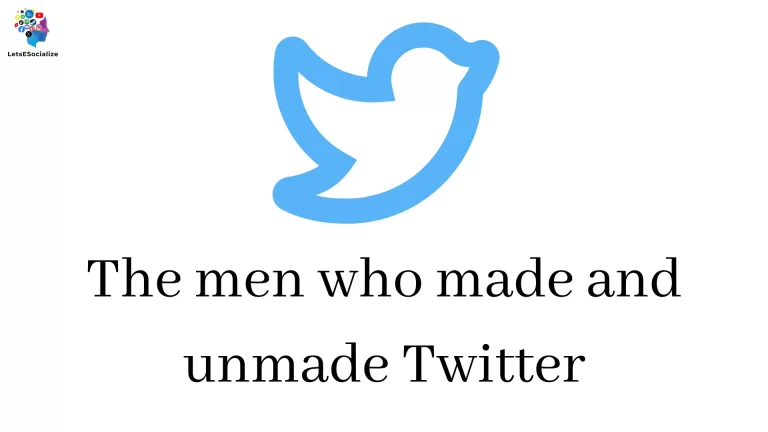Twitter ads offer an attractive way for businesses to reach their target audiences and promote products or services. However many marketers find that their Twitter ad campaigns fail to generate a positive return on investment, making them unprofitable.
In this comprehensive guide, we will delve into the various reasons why are Twitter ads not profitable for certain businesses. We will also provide actionable tips and best practices you can implement to improve Twitter ad performance and profitability.
So let’s get started and figure out why your hard-earned marketing dollars may be vanishing into the Twitterverse without giving you profitable results!
Table of Contents
Common Reasons for Twitter Ads’ Underperformance

Before we look at solutions, it is important to diagnose the potential issues that may be causing subpar performance and loss-making campaigns on Twitter Ads:
1. Weak Targeting Strategy
The most common mistake is using broad targeting approaches that end up showing your ads to huge audiences unlikely to be interested in your offerings. This wastes the budget on irrelevant impressions and leads to poor engagement and conversions.
2. Low Relevance Scores
If your ads and targeting keywords are unrelated to each other, Twitter’s algorithms will assign you a low relevance score, hurting campaign performance. Keep your ads tightly aligned to strategic targeting.
3. Ignoring Negative Keywords
Not actively using negative keywords causes your ads to show for searches unrelated to your business, destroying campaign relevancy. Keep optimizing for negative keywords.
4. Clicking Your Ads
Some marketers click their ads out of curiosity to check landing pages or from multiple accounts to inflate numbers. This stacks up needless self-inflicted costs. Avoid this vanity trap!
5. Bid Prices Too High
Bidding aggressively beyond your targets for impression or conversion volume can inflate costs without proportional gains in results, eating away at profitability. Right-size your bids carefully.
6. Narrow Audience Interests
If your customer niche is focused on very narrow interests not widely shared, it becomes hard to scale ads profitably on Twitter beyond a limited engaged subset. Expand to adjacent interests or segments.
7. Weak/Misaligned Offer or CTA
A bad offer or call-to-action irrelevant to the audience’s needs can hamper conversions even with good targeting. Continue A/B testing offers & CTAs.
8. Poor Ad Copywriting
Ads with boring copy or that fail to communicate concrete benefits attract limited engagement. Pour your creativity into crafting compelling ad copy optimized for response.
9. Cluttered Ad Visuals
Visually dense or cluttered ad images overwhelm viewers and fail to convey your message clearly in the tiny ad real estate. Refine visuals to highlight the value proposition.
10. Directing To Poor Landing Pages
Sending traffic to a disjointed landing page lacking clear follow-up actions can impede conversions. Send them to tailored landing pages with strong calls to action.
Analyzing which of these factors apply to your underperforming campaigns will help identify the source areas you need to fix. Now let’s move on to…
Tips to Improve Twitter Ads Profitability
Here are some actionable tips and best practices to help you enhance your Twitter ad performance, lower cost-per-results, and maximize return on your ad spend:
1. Granular Targeting
Leverage Twitter’s robust targeting capabilities like keywords, interests, behaviors, follower look-alikes, website visitors, etc. to reach your ideal customers within your niche.
2. Measure & Optimize Relevance
Check relevance scores in your Analytics and optimize targeting, bids, negative keywords, etc. to achieve over 7+ relevance for each campaign.
3. Tighten Geographic Targeting
Limit campaigns to countries or regions where you can offer your products or services to avoid stray spending.
4. Pause Low Performers
Pause poorly performing ads and targets instead of stopping campaigns. This allows you to reactivate them later once optimized.
5. Add Negative Keywords
Keep diligently adding granular negative keywords to exclude irrelevant searches that trigger your ads. Review search term reports regularly.
6. Enable Conversion Tracking
Implement Twitter’s conversion tracking pixel on your website to accurately measure the impact and ROI of your Twitter ads.
7. Create Custom Audiences
Build custom audiences of existing customers, website visitors, past webinar attendees, etc. to activate valuable lookalike audiences.
8. Optimize Campaign Objectives
Ensure campaign objectives like tweet engagements, follows, and app installs are set according to actual business goals and optimized towards them.
9. Test Ad Variations
Create multiple ad variations testing different images, copy, CTAs, etc., and cull low performers based on social proof & engagement metrics.
10. Retarget Engaged Users
Create campaigns retargeting users who previously clicked your ads or content to focus spending on those with demonstrated interest.
Executing these 10 tweaks methodically will help transform loss-making Twitter ad campaigns into profitable drivers of valuable conversions for your business. Let’s build on these further with some more best practices.
More Advanced Twitter Ads Profitability Best Practices
Beyond the tips covered already, implementing the following set of proven profitability best practices can give your Twitter ads performance and ROI an added boost:
- A/B Test Ads Aggressively – Continuously test new ad creative and target variations against existing control versions to drive incremental gains.
- Cull Underperformers Quickly – Be ruthless about pausing or killing ad variants or targets not delivering results fast enough to maximize your profitability.
- Target Warm Audiences – People who already know your brand or competitors make warm, highly convertible targets versus totally cold traffic.
- Reuse Top Performing Assets – Repurpose your best ad copy, images, and videos across campaigns to multiply profitable results.
- Optimizing Landing Pages – Ensure your landing pages reinforce ad messaging and contain clear follow-up CTAs to convert visitors.
- Lower Funnel Targeting – Use more bottom-of-funnel targeting like product names, specific content topics, and brand keywords for high-intent traffic.
- Dayparting Targets – Run certain ad targets during dayparts when they are more likely to convert based on your audience’s buying rhythms throughout the day or week.
- Optimize Bidding Strategy – Efficient bidding strategies like target CPA bidding can help maximize conversions profitably within budget caps.
- Refine Remarketing – Create tailored remarketing campaigns for buyers at different stages like page visitors, and add-to-cart vs purchasers to make re-engagement more relevant.
- Review Reporting Diligently – Analyze campaign analytics frequently and make ongoing tweaks to targets, bids, budgets, and creativity in response to performance patterns.
Adopting an optimization mindset and applying these advanced profitability best practices will help you extract the maximum value from your Twitter ads investment.
Now let’s look at an optimization case study demonstrating the impact of implementing some of these tactics.
Twitter Ads Profitability Case Study
Here is a short case study illustrating how a retail brand was able to turn its Twitter ads from an unprofitable cost center into a profitable engine driving valuable conversions through systematic optimization efforts:
Campaign Diagnosis
Our retailer was running several Twitter ad campaigns targeting a few broad interests and keyword targets like “online shopping”, “fashion”, and “women’s shoes”. But costs were exceeding sales generated, making the campaigns unprofitable with negative ROI.
Optimization Efforts
We helped them implement several changes to their Twitter ads strategy:
- Tighten targeting to interests like fashion bloggers, shoe designers, specific shoe styles, and keyword searches around major shoe brands.
- Created custom audiences of existing customers and website visitors to activate lookalike audiences.
- Implemented negative keywords to exclude irrelevant searches.
- Tested ad variations with different captions and shoe images.
- Started retargeting engaged users.
- Reduced bid prices and optimized for conversion events.
Impact on Profitability
Within 2 months of implementing these changes, the impact was highly positive:
- Click Through Rates increased from 0.4% to 1.5%
- Conversion rates doubled from 2.3% to 5.1%
- Cost per purchase dropped from $42 to $22
- Overall campaign ROI turned positive, delivering $3.2 profit per $1 spent
So through systematic optimization efforts, the retailer was able to turn their Twitter ads into a profitable channel driving valuable foot traffic and conversions.
The right strategic optimizations can similarly help you transform inefficient Twitter ads into profitable drivers of business growth. Let’s now look at some common troubleshooting questions around Twitter ad’s profitability.
Also read: Case studies of successful Twitter Ads
Twitter Ads Profitability Troubleshooting Guide
Here are answers to some frequently asked troubleshooting questions about improving Twitter ad results and profitability:
-
How much should I budget per day for profitable Twitter ads?
Begin with $10-$15 per day for testing. Once you find profitable targets and optimize your funnel, scale daily budgets up to $50-$100.
-
What engagement or conversion rate is required for profitable Twitter ads?
3-6% clickthrough rate, 10-20% engagement rate, and 2-4% conversion rates from clicks are general profitability benchmarks to aim for.
-
Should I use manual or automatic bidding for profitable campaigns?
Start with manual CPC bidding to control costs. Once targets and funnel are profitable, auto-bidding works well to scale campaigns up.
-
My business has limited products. Are Twitter ads still suitable?
Yes, focus on really honing your targeting to market well to a narrower, high-intent audience interested specifically in your niche offerings.
-
How often should I check campaign analytics to optimize profitability?
Check performance daily at first, then move to a 3 times a week cadence once campaigns are profitable, making occasional optimizations.
Gaining clarity on questions like these will help you troubleshoot any profitability or performance issues with your Twitter ads and realign them toward profitability.
Recap and Key Takeaways
Let’s quickly recap how you can shift your Twitter ads toward profitability:
- Common reasons for unprofitable Twitter ads are weak targeting, low relevance, ignoring negative keywords, self-clicks, high bids, narrow interests, bad offers and CTAs, poor copy and visuals, etc.
- Tips to enhance profitability include granular targeting, measuring relevance, tightening locations, pausing low performers, adding negatives, conversion tracking, custom/lookalike audiences, optimizing objectives, and testing ad variations.
- Advanced best practices involve aggressive testing, quick culling, targeting warm audiences, reusing top assets, optimizing landing pages, lower funnel targeting, dayparting, strategic bidding, tailored remarketing, and diligent reporting analysis.
- The case study showed how a retailer turned from negative ROI to over 300% ROI on Twitter ads through systematic optimization across targeting, audiences, negatives, testing, bidding, etc.
- Common troubleshooting questions around budgets, ideal engagement rates, bidding strategies, niche businesses, and analytics review cadence have been answered.
With these proven strategies and best practices, you are now equipped to transform your own Twitter ads into profitable channels driving valuable conversions and ROI for your business. Time to stop wasting money and start seeing profitable results!







